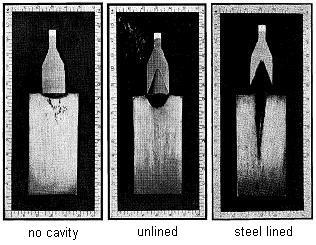-
Legacy Member

Prob'ly not from the front , but there looks to be a hole or two in the side between the tracks . Quite a bit thinner there.
Chris
-
Thank You to emmagee1917 For This Useful Post:
-
02-12-2014 11:31 AM
# ADS
Friends and Sponsors

-
Advisory Panel


I'd have to get into the books and see what it can punch through...never used those.
-
-
Legacy Member

The standard anti-tank rifle grenade M9A1 had a "shaped charge" that when ignited formed a concentrated jet, similar to a welding torch, that burned through armor plate. (The shoulder launched AT rocket popularly known as a "Bazooka" also had a shaped charge) The AT rifle grenade was incapable of penetrating any but the thinnest of armor, and even then under ideal conditions of angle of attack and etc. The charge had to be ignited a certain distance from the target in order for the jet to form properly. The hole that the AT rifle grenade created was no more than around a quarter inch in diameter and would not be visible in the image the subject of this thread.
Upon penetration the jet stream could cause damage to internal components, detonate ammunition, ignite fuel, burn crew, and consume oxygen in the vehicle. In addition there was a slight "spalling" effect of small pieces of armor and anything else inside the vehicle that was in a sense shrapnel that could cause injury.
The "skirts" on and stand-off armor applied to German tanks late in WWII was intended to defeat shaped charge munitions. RPG and many other direct fire AT munitions use the same principle of the shaped charge. In later application the "reactive armor" used on U.S. tanks during the Gulf War was intended to prematurely ignite the shaped charge so that the jet was expended before it could penetrate the armor. The multi layered armor on the current tanks defeats shaped charge munitions by causing the jet to be dispersed in the intervening layers of the armor.
tanks late in WWII was intended to defeat shaped charge munitions. RPG and many other direct fire AT munitions use the same principle of the shaped charge. In later application the "reactive armor" used on U.S. tanks during the Gulf War was intended to prematurely ignite the shaped charge so that the jet was expended before it could penetrate the armor. The multi layered armor on the current tanks defeats shaped charge munitions by causing the jet to be dispersed in the intervening layers of the armor.
This type munitions in U.S. use is known as High Explosive Anti-Tank (HEAT). A much more effective munition to defeat armor is the Amour Piercing Discarding Sabot (APDS) munition which features a depleted uranium bolt, that is fired at high velocity, and simply penetrates armor and creates more of the spalling effect described previously. The sabot or bolt is only about an inch in diameter and creates an almost indiscernible hole on the exterior of the armor where penetrated. This type munitions will penetrate well beyond the thickest armor carried on any AFV.
-
The Following 2 Members Say Thank You to RT Ellis For This Useful Post:
-
Advisory Panel


I understand all of that and knew that already as I did 35 years army myself...no mystery there. The question here was how thick? How much does that particular AT grenade defeat? That's what I have to check out...
-
-
Legacy Member

AT Rifle and Bazooka maximum performance
U.S. M9 AT Rifle Grenade - 1.5 inches, M9A1 - 2 inches armor effective range both 75 yards.
U.S. 2.36 inch rocket - 3 inches armor effective range 400 yards.
Comment: In the film "To Hell and Back" Audie Murphy used a rifle grenade to succesfully damage the track of a German tank that was being repaired. This incident was not mentioned in his book of the same title but presumeably recreated an actual incident.
tank that was being repaired. This incident was not mentioned in his book of the same title but presumeably recreated an actual incident.
-
The Following 3 Members Say Thank You to RT Ellis For This Useful Post:
-
Contributing Member


He is no fool who gives what he cannot keep to gain that which he cannot lose
There are no great men, only great challenges that ordinary men are forced by circumstances to meet.
-
Thank You to Mark in Rochester For This Useful Post:














 PM
PM










